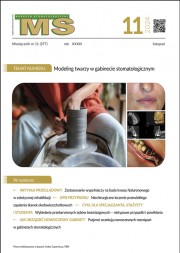Dostęp do tego artykułu jest płatny.
Zapraszamy do zakupu!
Cena: 6.15 PLN (z VAT)
Kup artykuł
Po dokonaniu zakupu artykuł w postaci pliku PDF prześlemy bezpośrednio pod twój adres e-mail.
Marcin Metlerski, Magda Aniko-Włodarczyk, Olga Preuss, Grzegorz Trybek
Streszczenie
Szybki rozwój metod obrazowania struktur anatomicznych, ich akwizycji oraz możliwość cyfrowego przetwarzania danych medycznych wraz z postępem w dziedzinie wytwarzania modeli stworzyły nowe możliwości wykorzystania modelowania medycznego. Druk 3D jest procesem wytwarzania trójwymiarowych obiektów fizycznych na podstawie modelu komputerowego. Modele przestrzenne poprawiają jakość i usprawniają proces planowania zabiegu chirurgicznego, zmniejszając tym samym ryzyko błędu i powikłań pozabiegowych.
Abstract
The quickly‑developing imaging methods for anatomical structures, their availability and possibility of digitalization of medical data, together with progress in the field of making models, have created new possibilities of making use of medical models. 3D printing is a process of producing three dimensional physical objects on the basis of a computer model. Spatial models improve e‑dimensions, improve quality and improve the process of treatment planning of surgery, at the same time reducing the risk of mistakes and reduce postoperative complications.
Hasła indeksowe: druk 3D, model medyczny, modelowanie medyczne
Key words: 3D printing, medical model, medical modelling
PIŚMIENNICTWO
1. Stansbury J.W., Idacavage M.J.: 3D printing with polymers: challenges among expanding options and opportunities. Dent. Mater., 2016, 32, 1, 54‑64.
2. Barazanchi A., Li K.C., Al ‑Amleh B. i wsp.: Additive technology: update on current materials and applications in dentistry. J. Prosthodont., 2016, 23, doi: 10.1111/jopr.12510.
3. Ozan O., Turkyilmaz I., Ersoy A.E. i wsp.: Clinical accuracy of 3 different types of computed tomography‑derived stereolithographic surgical guides in implant placement. J. Oral Maxillofac. Surg., 2009, 67, 2, 394‑401.
4. Miechowicz S.: Synteza modelowania złożonych struktur geometrycznych w zastosowaniach medycznych. Oficyna Wydawnicza Politechniki Rzeszowskiej, Rzeszów 2012.
5. Kalra M., Aparna, I.N., Dhanasekar B.: Evolution of surgical guidance in implant dentistry. Dent. Update, 2013, 40, 7, 577‑8, 581‑582.
6. Tahmaseb A., Wismeijer D., Coucke W., Derksen W.: Computer technology applications in surgical implant dentistry: a systematic review. Int. J. Oral Maxillofac. Implants, 2014, 29, 25‑42.
7. Widmann G., Bale R.J.: Accuracy in computer‑aided implant surgery – a review. Int. J. Oral Maxillofac. Implants, 2006, 21, 2, 305‑313.
8. Schneider D., Marquardt P., Zwahlen M., Jung R.E.: A systematic review on the accuracy and the clinical outcome of computer‑guided template‑based implant dentistry. Clin. Oral Implants Res., 2009, 20, 4, 73‑86.
9. Juergens P., Krol Z., Zeilhofer H.F. i wsp.: Computer simulation and rapid prototyping for the reconstruction of the mandible. J. Oral Maxillofac. Surg., 2009, 67, 10, 2167‑2170.
10. Kaye R., Goldstein T., Zeltsman D. i wsp.: Three dimensional printing: a review on the utility within medicine and otolaryngology. Int. J. Pediatr. Otorhinolaryngol., 2016, 89, 145‑148.
Streszczenie
Szybki rozwój metod obrazowania struktur anatomicznych, ich akwizycji oraz możliwość cyfrowego przetwarzania danych medycznych wraz z postępem w dziedzinie wytwarzania modeli stworzyły nowe możliwości wykorzystania modelowania medycznego. Druk 3D jest procesem wytwarzania trójwymiarowych obiektów fizycznych na podstawie modelu komputerowego. Modele przestrzenne poprawiają jakość i usprawniają proces planowania zabiegu chirurgicznego, zmniejszając tym samym ryzyko błędu i powikłań pozabiegowych.
Abstract
The quickly‑developing imaging methods for anatomical structures, their availability and possibility of digitalization of medical data, together with progress in the field of making models, have created new possibilities of making use of medical models. 3D printing is a process of producing three dimensional physical objects on the basis of a computer model. Spatial models improve e‑dimensions, improve quality and improve the process of treatment planning of surgery, at the same time reducing the risk of mistakes and reduce postoperative complications.
Hasła indeksowe: druk 3D, model medyczny, modelowanie medyczne
Key words: 3D printing, medical model, medical modelling
PIŚMIENNICTWO
1. Stansbury J.W., Idacavage M.J.: 3D printing with polymers: challenges among expanding options and opportunities. Dent. Mater., 2016, 32, 1, 54‑64.
2. Barazanchi A., Li K.C., Al ‑Amleh B. i wsp.: Additive technology: update on current materials and applications in dentistry. J. Prosthodont., 2016, 23, doi: 10.1111/jopr.12510.
3. Ozan O., Turkyilmaz I., Ersoy A.E. i wsp.: Clinical accuracy of 3 different types of computed tomography‑derived stereolithographic surgical guides in implant placement. J. Oral Maxillofac. Surg., 2009, 67, 2, 394‑401.
4. Miechowicz S.: Synteza modelowania złożonych struktur geometrycznych w zastosowaniach medycznych. Oficyna Wydawnicza Politechniki Rzeszowskiej, Rzeszów 2012.
5. Kalra M., Aparna, I.N., Dhanasekar B.: Evolution of surgical guidance in implant dentistry. Dent. Update, 2013, 40, 7, 577‑8, 581‑582.
6. Tahmaseb A., Wismeijer D., Coucke W., Derksen W.: Computer technology applications in surgical implant dentistry: a systematic review. Int. J. Oral Maxillofac. Implants, 2014, 29, 25‑42.
7. Widmann G., Bale R.J.: Accuracy in computer‑aided implant surgery – a review. Int. J. Oral Maxillofac. Implants, 2006, 21, 2, 305‑313.
8. Schneider D., Marquardt P., Zwahlen M., Jung R.E.: A systematic review on the accuracy and the clinical outcome of computer‑guided template‑based implant dentistry. Clin. Oral Implants Res., 2009, 20, 4, 73‑86.
9. Juergens P., Krol Z., Zeilhofer H.F. i wsp.: Computer simulation and rapid prototyping for the reconstruction of the mandible. J. Oral Maxillofac. Surg., 2009, 67, 10, 2167‑2170.
10. Kaye R., Goldstein T., Zeltsman D. i wsp.: Three dimensional printing: a review on the utility within medicine and otolaryngology. Int. J. Pediatr. Otorhinolaryngol., 2016, 89, 145‑148.













